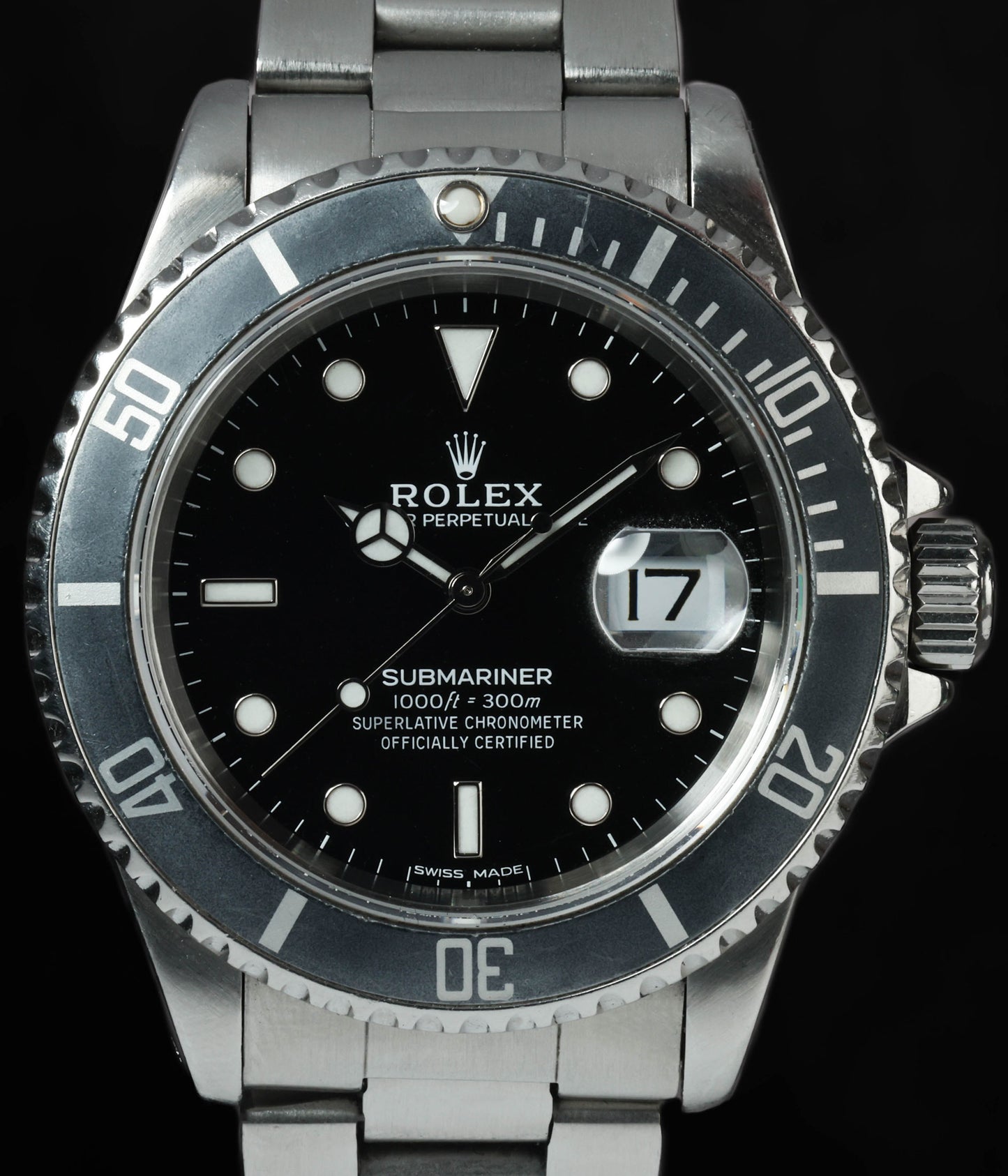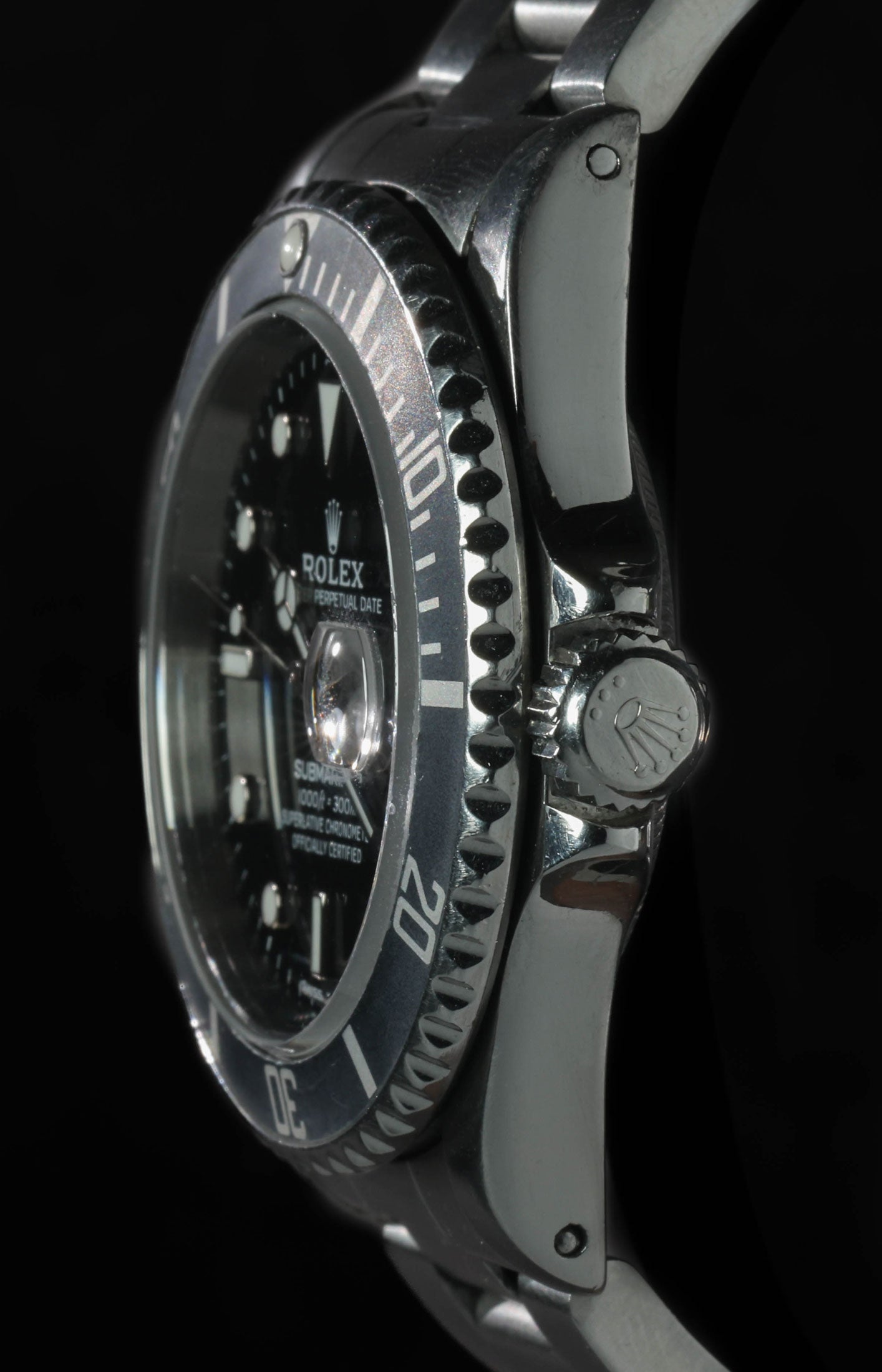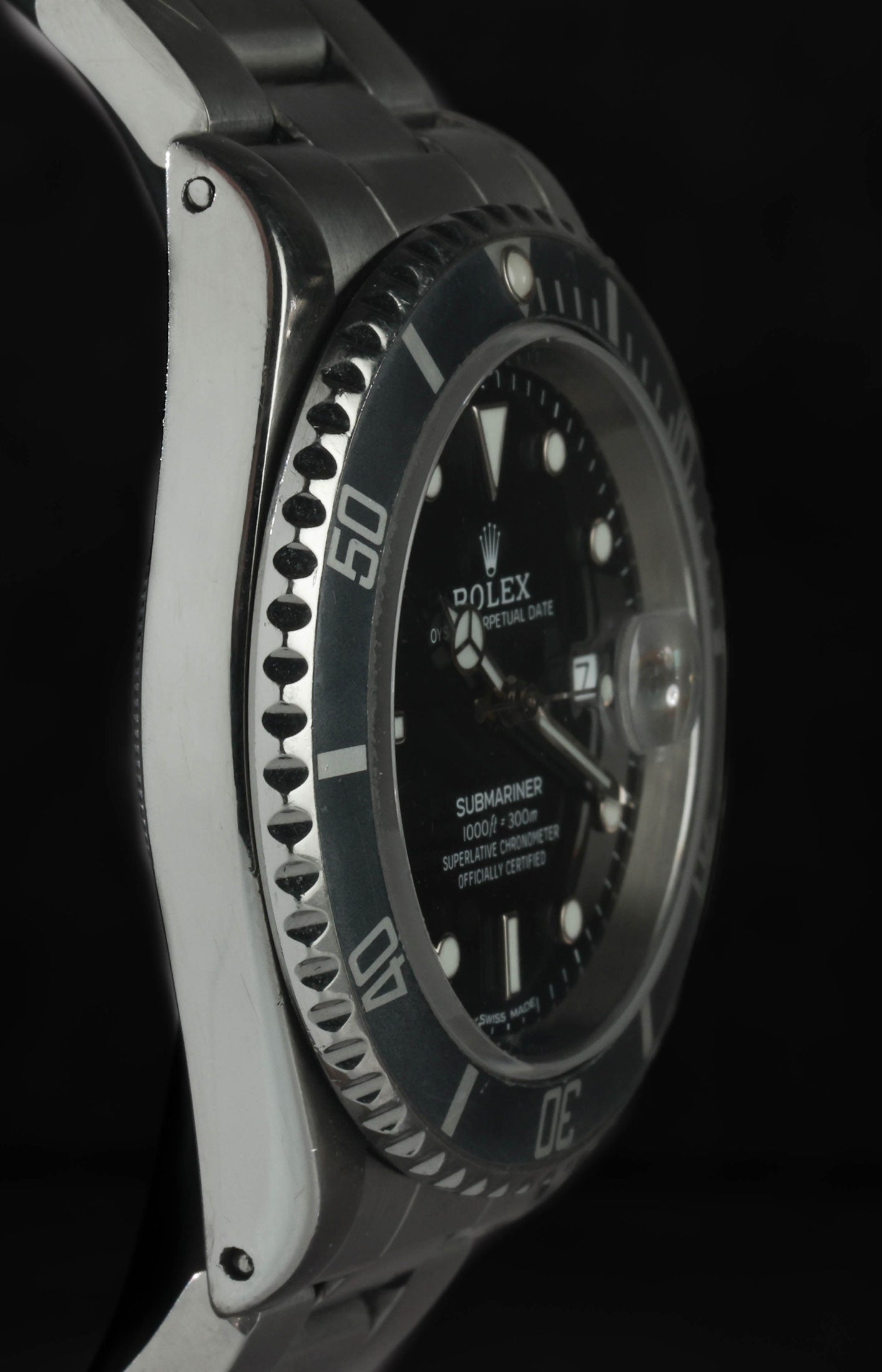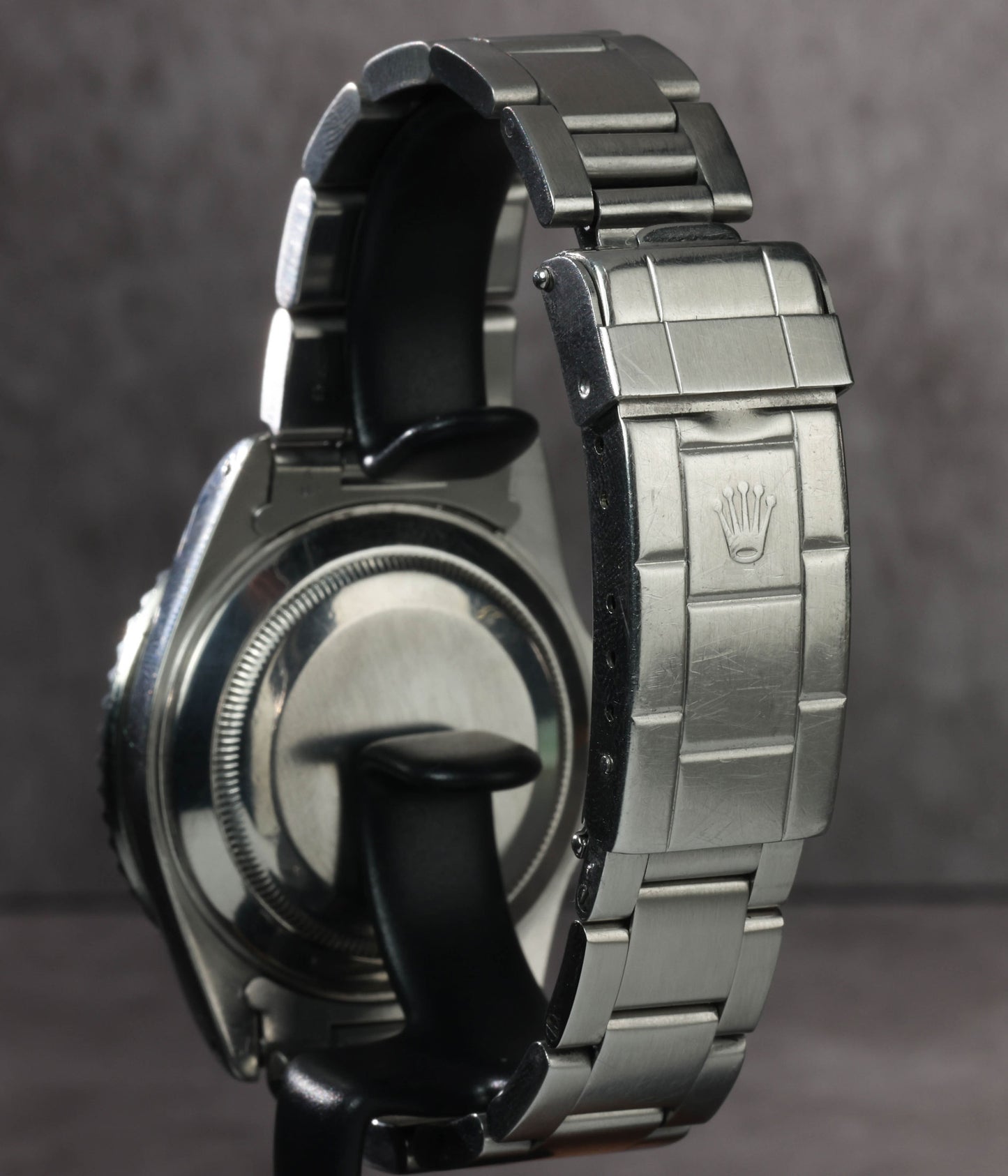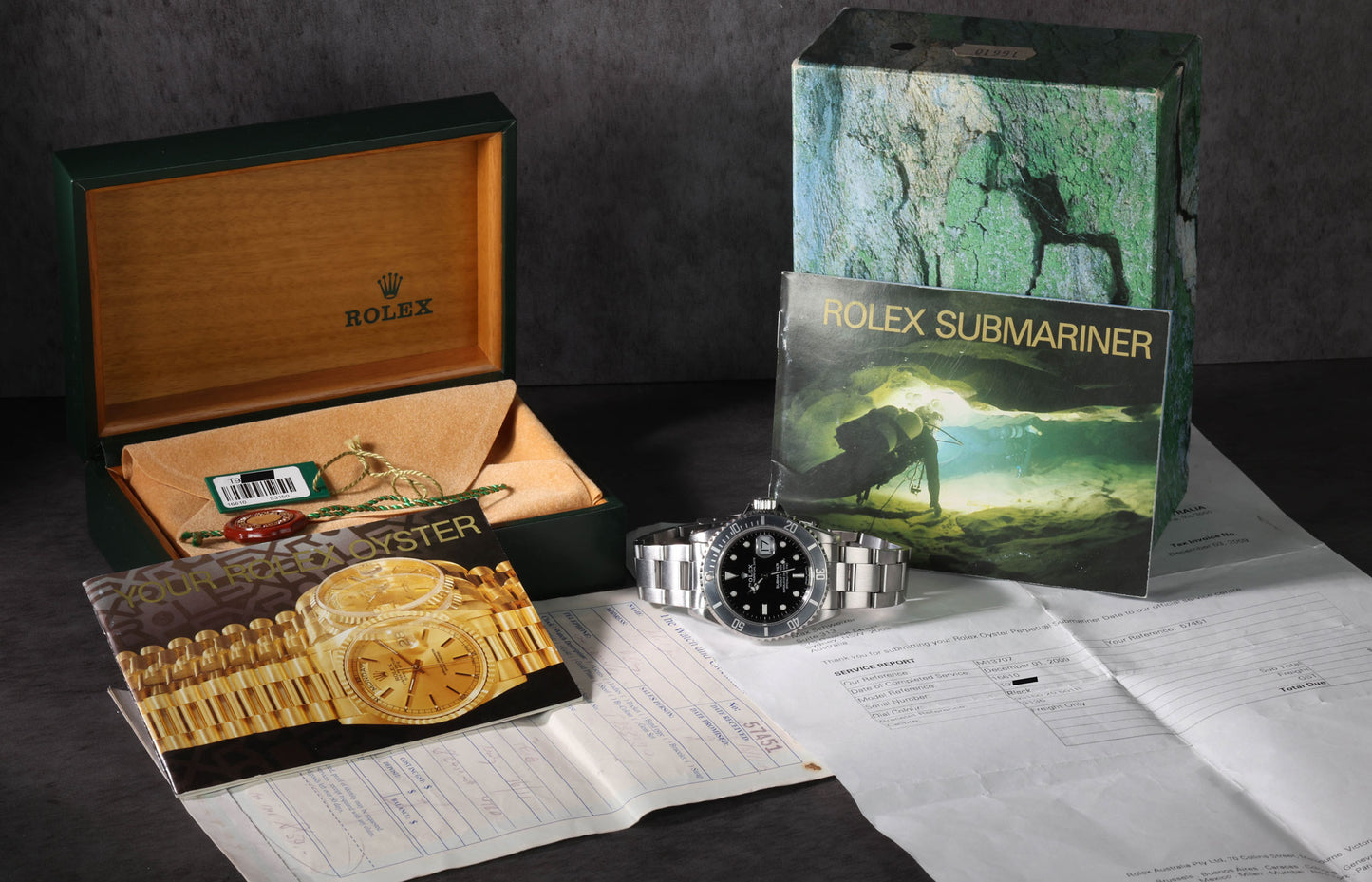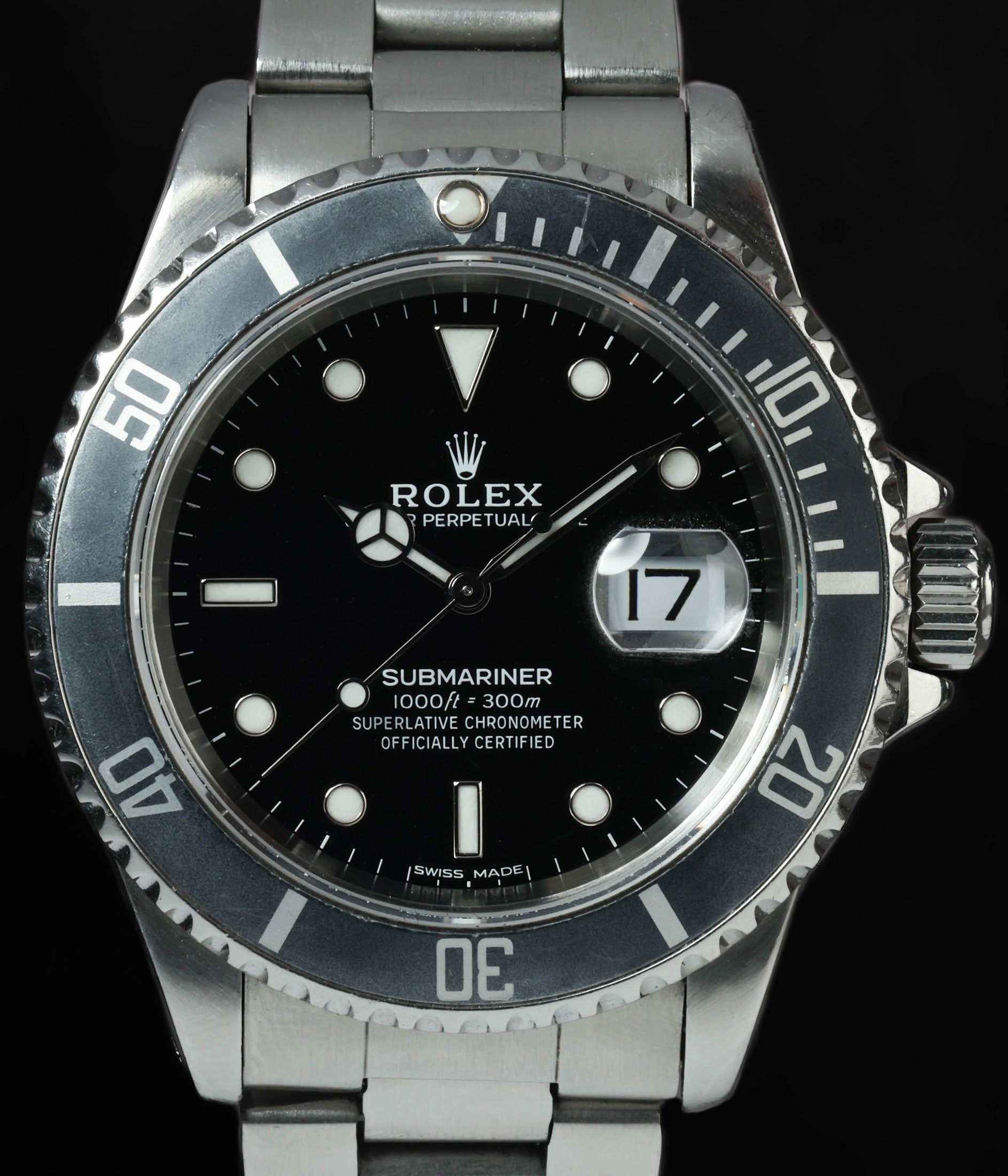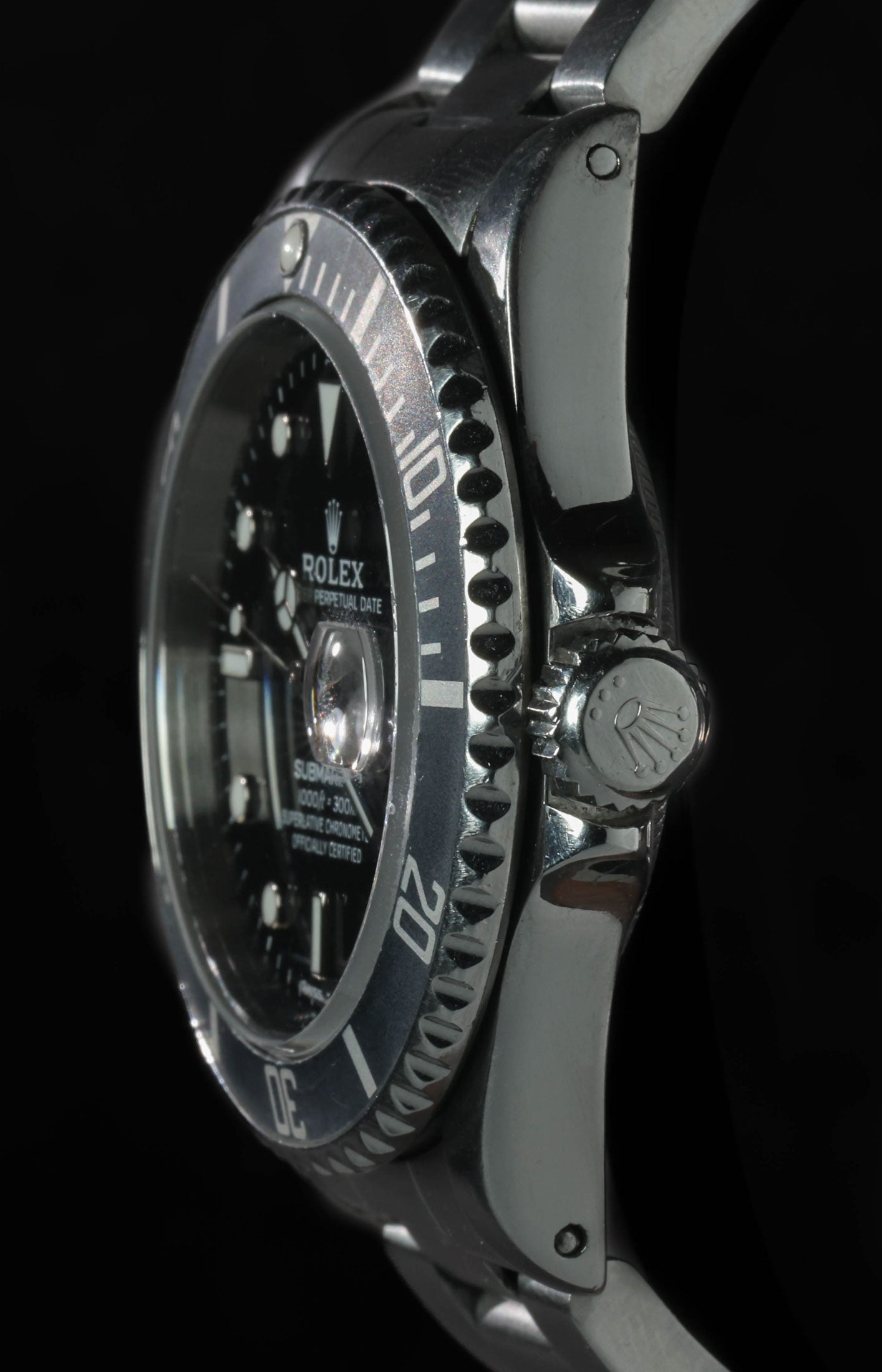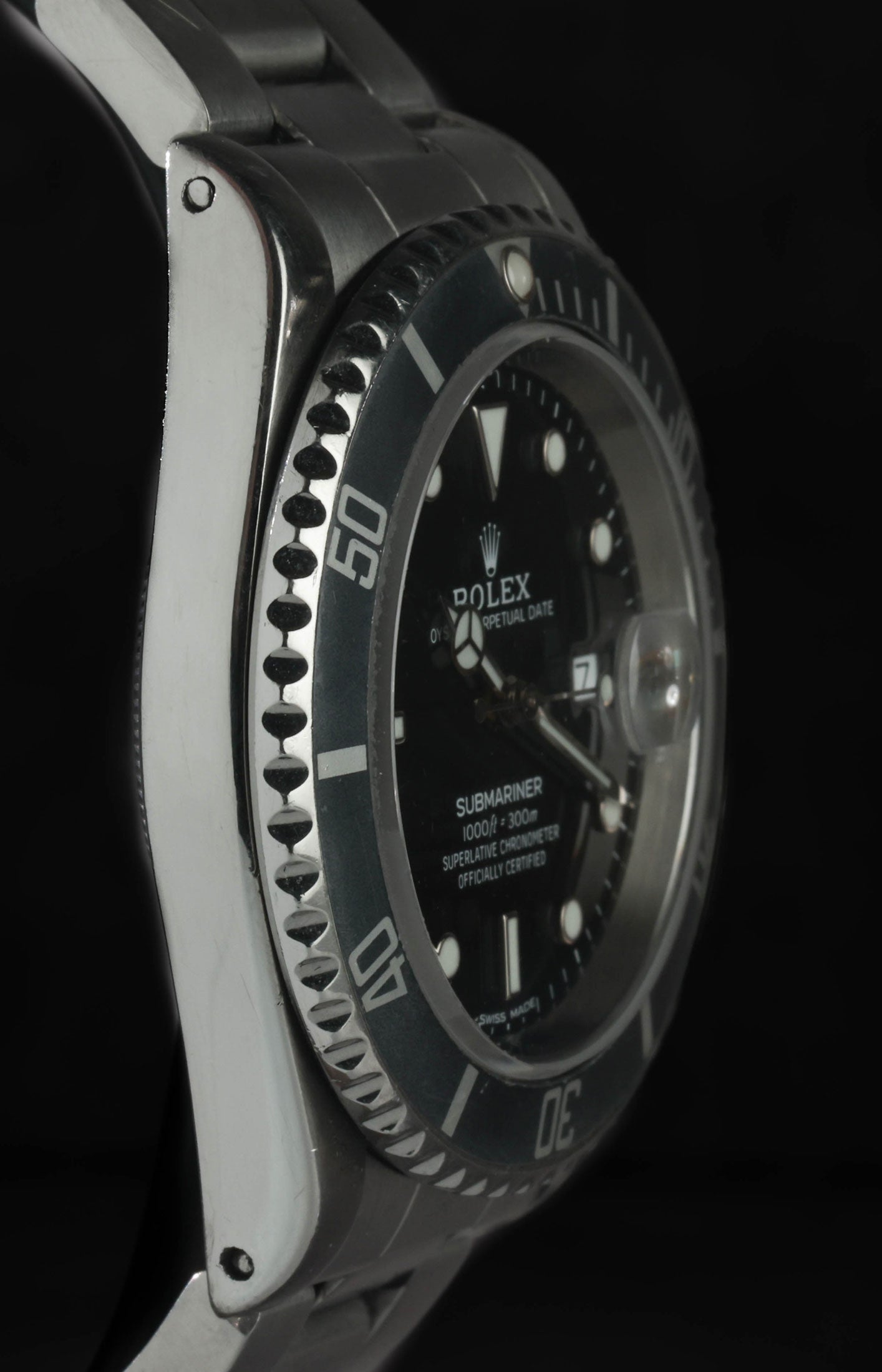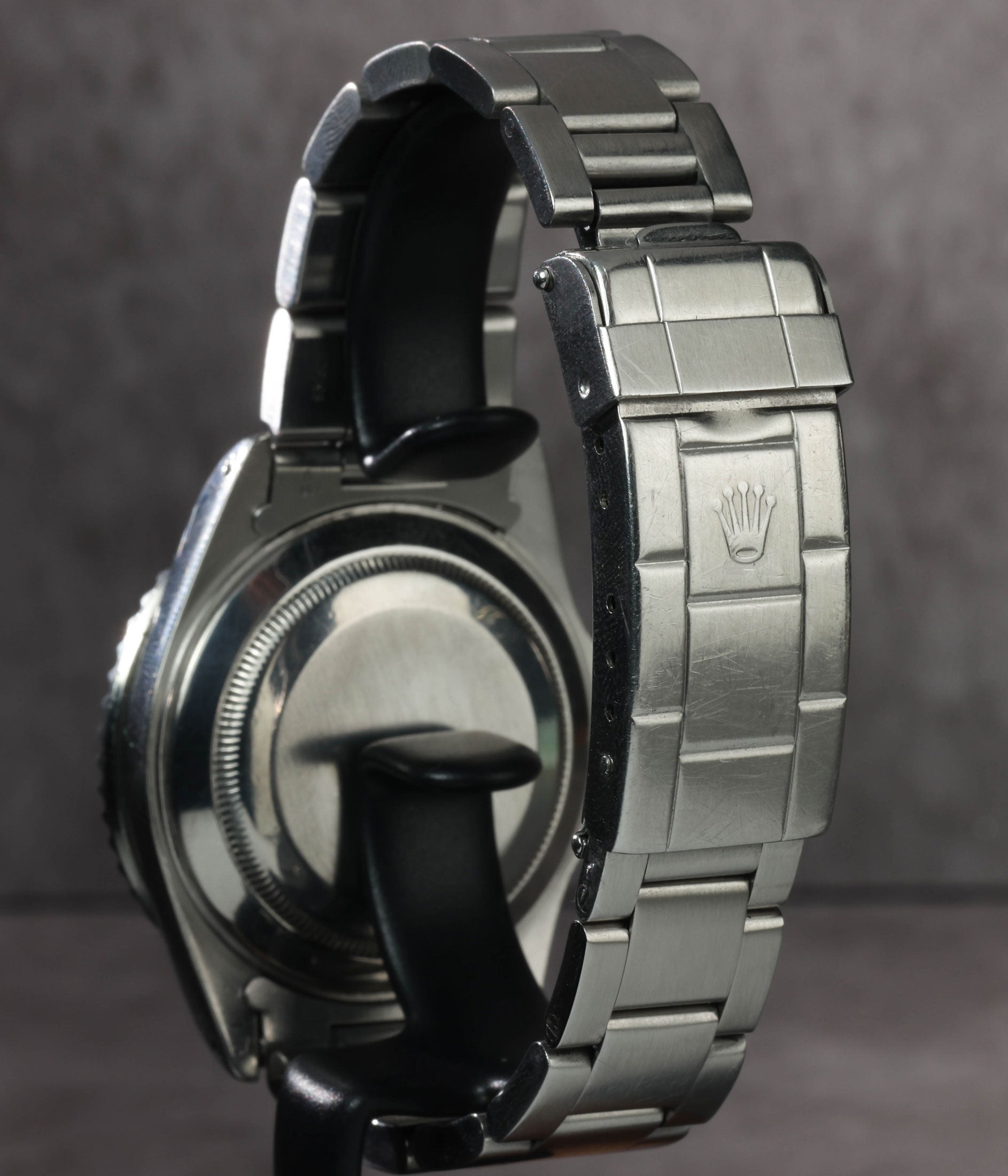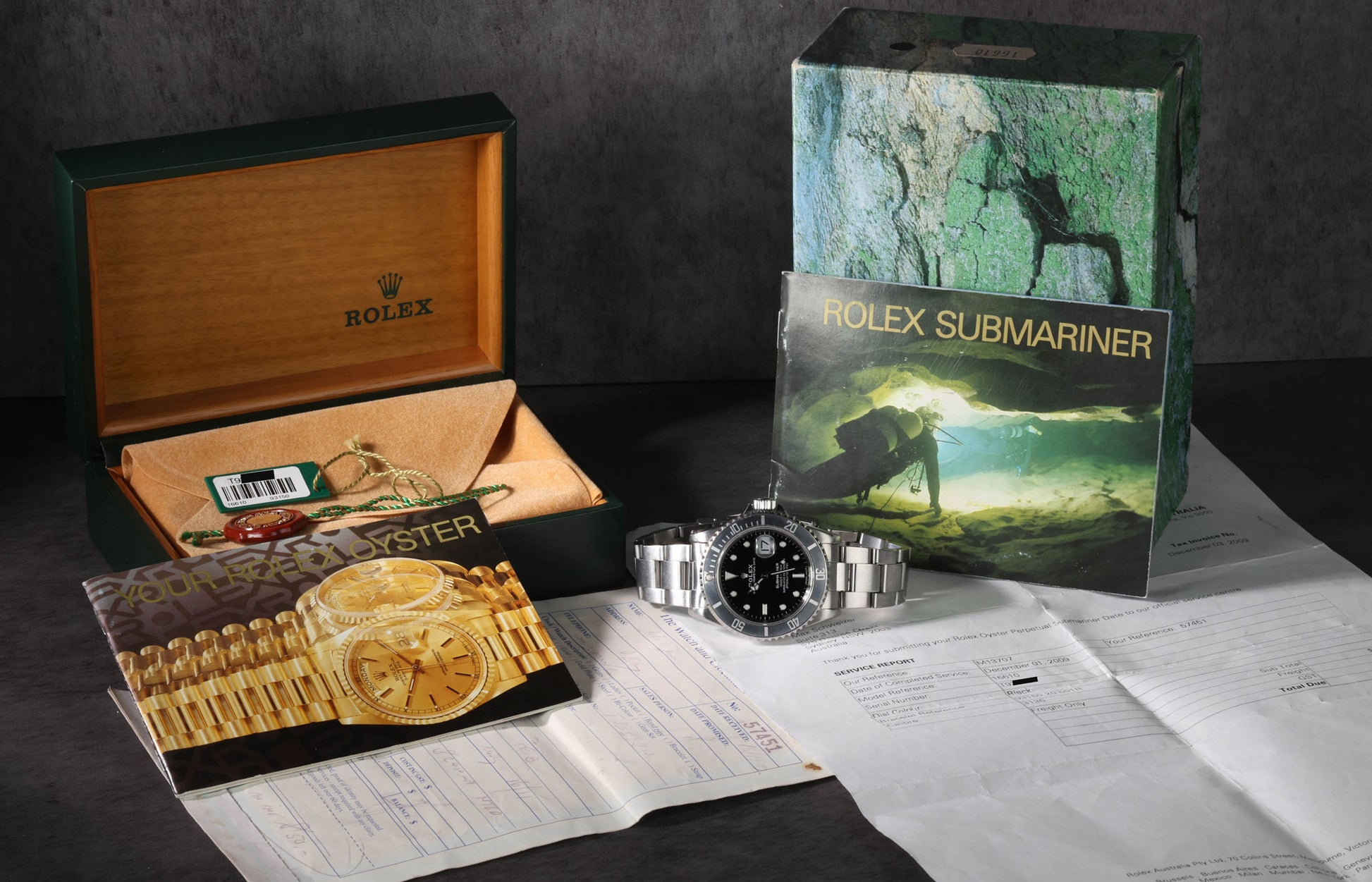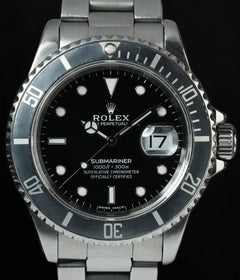Crown Vintage
Rolex Submariner 40mm 16610 1996 Box & Papers
Rolex Submariner 40mm 16610 1996 Box & Papers
Couldn't load pickup availability
Rolex Submariner 16610
The case is in great condition, showing only minor signs of wear consistent with age. It has undergone a light polish, preserving its original lines and proportions. The bracelet presents with light hairlines throughout and has also been polished, maintaining a clean appearance overall. The dial and hands are flawless and present as service replacements, contributing to the watch’s clean and refreshed aesthetic.
Share
Why we love this watch
Why we love this watch
Rolex Submariner 16610: Evolution of a Legend
Origins of the Submariner
By 1996, the Rolex Submariner had already been etched into the annals of horological history. First released in 1953, the Submariner was Rolex’s answer to the growing demand for robust underwater timekeeping during the golden age of SCUBA diving. Its earliest references—6204 and 6205—laid the groundwork with a rotating bezel, waterproof case, and a no-nonsense dial design for maximum legibility in challenging conditions. However, it wasn’t until the reference 6538 appeared on Sean Connery’s wrist in Dr. No that the Submariner achieved pop-cultural immortality.
The model has evolved considerably over the decades, not only as a tool watch but as a statement piece. The 16610 reference, introduced in 1989, signified a new chapter in the Submariner’s lineage—a subtle yet decisive evolution of a classic.
Enter Reference 16610
The Rolex Submariner 16610 replaced the outgoing reference 168000 and remained in production until around 2010. It retained much of the classic Submariner aesthetic but featured modernised internals and subtle refinements that laid the groundwork for the current generation of Submariners.
The 1996 version of the 16610 sits in the middle of this production run and offers a fascinating snapshot of Rolex in transition. While the watch still features tritium lume (indicated by the “SWISS – T<25” marking at 6 o’clock), Rolex had already begun implementing incremental upgrades that hinted at future innovations.
Case and Bezel
The stainless steel case of the 16610 measured 40mm in diameter and approximately 13mm in thickness. Constructed from 904L stainless steel—Rolex’s proprietary corrosion-resistant alloy—the case was designed to take a beating while remaining impervious to seawater and sweat alike.
It came fitted with a unidirectional rotating bezel featuring an aluminium insert, black in colour, marked with a 60-minute dive scale. Unlike later ceramic bezels, these aluminium inserts were prone to fading and scratching, giving each example a unique wear pattern. Many collectors seek out models with bezel inserts that have faded to ghost-grey or blue—hallmarks of real-world use and age.
Crown guards flank the Triplock screw-down crown, reinforcing the Submariner’s reputation as a true dive tool rated for 300 metres (1000 feet) of water resistance. The caseback remained solid and screw-down, as with all Rolex Oyster models.
Dial and Hands
The dial of the 1996 Submariner 16610 is a quintessential black gloss surface with white gold surrounds for the hour markers—an understated luxury touch. The lume plots, in this case, are tritium-based, which means they have likely developed a warm patina over the years. The original tritium lume stopped glowing decades ago, but its visual character has only grown richer. This particular watch comes with a Super-LumiNova service dial.
The Mercedes-style hour hand, sword-shaped minute hand, and lollipop seconds hand complete the classic Rolex dive watch look. The date window at 3 o’clock is magnified by the Cyclops lens affixed to the sapphire crystal—another Rolex signature.
Bracelet and Clasp
The bracelet fitted to the 16610 was the Oyster bracelet, reference 93150, crafted from 904L steel. Early 1996 models typically feature hollow end links (as solid end links did not appear until later in the production), adding a jangly charm to the overall feel. The bracelet links were also hollow, making the bracelet significantly lighter than the solid-link versions found on modern Submariners.
The clasp was a fold-over Oysterlock with a stamped steel diver’s extension hidden beneath the buckle, allowing quick adjustment to fit over a wetsuit.
Movement: Calibre 3135
Powering the 16610 is Rolex’s in-house calibre 3135, an automatic movement introduced in 1988 and still used (with updates) in several Rolex watches well into the 2020s. The calibre 3135 is known for its reliability, ease of service, and accuracy.
It features a 28,800 beats-per-hour frequency, a full balance bridge, and a free-sprung balance with Microstella screws. The movement offers hacking seconds, a quick-set date function, and approximately 48 hours of power reserve. In keeping with Rolex’s standards, each movement was chronometer-certified by the COSC.
While some may view the 3135 as a workhorse, others regard it as one of the finest movements Rolex ever built—practical, tough, and easy to maintain.
1996: A Transitional Year
By 1996, the Submariner 16610 was firmly entrenched in Rolex’s line-up, but the brand had not yet introduced the luminova dials that would replace tritium entirely by 1998. This means 1996 dials are among the last few years to feature tritium lume. These “SWISS – T<25” dials are now highly sought after by vintage enthusiasts who prefer aged lume over the perpetual glow of modern alternatives.
Case finishing during this period also had the slightly softer brushing and polishing associated with Rolex’s pre-2000 watches. These characteristics, when unpolished, distinguish them from their later, more angular cousins.
Another subtle but meaningful trait of 1996 models is the presence of lug holes on the side of the case—later phased out around 2003. Lug holes make strap changes significantly easier and lend the watch an undeniably utilitarian charm. In recent years, lug holes have developed a cult following among collectors.
Daily Wearability and Appeal
Despite its age, the Submariner 16610 from remains remarkably wearable. Its 40mm case sits comfortably on most wrists thanks to its slim profile and light bracelet. The design is equally at home with jeans and a T-shirt or under the cuff of a dress shirt.
Unlike many modern watches, the 16610 doesn’t feel like it’s trying to shout. It is quietly confident, cleanly designed, and functionally perfect. These qualities explain why many collectors who own several watches still find themselves reaching for their 16610 more often than not.
The Submariner in the 1990s Context
The 1990s were a decade of refinement rather than reinvention for Rolex. Unlike the quartz crisis of the 1970s or the luxury boom of the 2000s, the ’90s represented a steady-as-she-goes approach. Rolex was building out its professional lines, improving materials and finishing, and quietly modernising its movements.
The 16610 was at the centre of this approach. It looked almost identical to its predecessor and only slightly different from its successor, yet each of those incremental changes mattered. In hindsight, it marked the last era before Rolex watches became widely seen as luxury status symbols rather than tool watches. In that sense, the 1996 Submariner is something of a final link in the chain to Rolex’s tool-watch past.
Why Collectors Love the 16610
Collectors appreciate the Submariner 16610 for its balance: not yet vintage, but not modern either. It’s the Submariner in its most classic form—aluminium bezel, tritium dial, lug holes, hollow end links, stamped clasp, and a pre-Super Case profile. It has all the vintage cues without the fragility of earlier models, offering the best of both worlds.
The fact that the 16610 had such a long production run (1989–2010) means it’s widely available.
Conclusion
The 1996 Rolex Submariner 16610 is a masterclass in evolution over revolution. It retained everything that made the Submariner iconic—understated design, superb legibility, rugged durability—while introducing modern refinements like the calibre 3135 and sapphire crystal.
This particular production year is a compelling chapter in the model’s story. With its tritium dial, aluminium bezel, and hollow bracelet links, the 1996 Submariner sits at the crossroads of vintage charm and everyday usability.
For the collector, it offers historical relevance, proven engineering, and timeless appeal. For the wearer, it’s a watch that disappears on the wrist until you need it. And for Rolex, it remains a benchmark of how to evolve a legend without losing the plot.
Case & Bracelet
Case & Bracelet
Case in great condition. It has had a light polish. Light hairlines on bracelet. The bracelet has also been polished.
Dial & Hands
Dial & Hands
- Dial and hands are flawless.
- Dial and hands are service dial and hands.
Warranty & Condition
Warranty & Condition
Crown Vintage Watches provides a minimum 3-month mechanical warranty on pre-owned watches, from the date of purchase.
The warranty covers mechanical defects only.
The warranty does not cover damages such as scratches, finish, crystals, glass, straps (leather, fabric or rubber damage due to wear and tear), damage resulting from wear under conditions exceeding the watch manufacturer’s water resistance limitations, and damage due to physical and or accidental abuse.
Please note, water resistance is neither tested nor guaranteed.
Shipping and insurance costs for warranty returns to us must be covered by the customer. Returns must be shipped via traceable courier. Return shipment must be pre-paid and fully insured. Collect shipping will be refused. In case of loss or damages, the customer is liable.
Our Pledge
At Crown Vintage Watches, we stand by the authenticity of every product we sell. For added peace of mind, customers are welcome to have items independently authenticated at their own expense.
Condition
Due to the nature of vintage timepieces, all watches are sold as is. We will accurately describe the current condition and working order of all watches we sell to the best of our ability.
Shipping & Refund
Shipping & Refund
